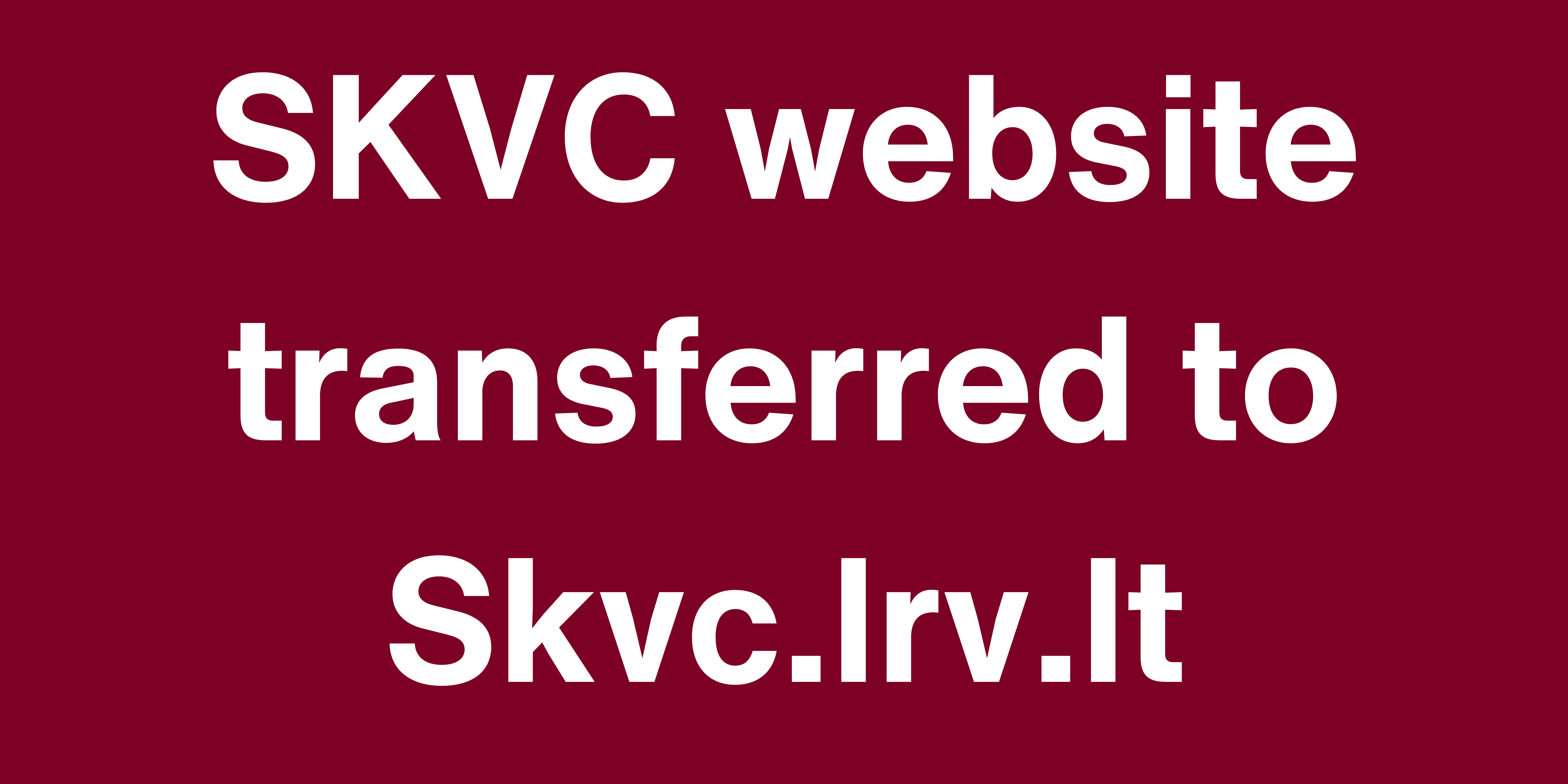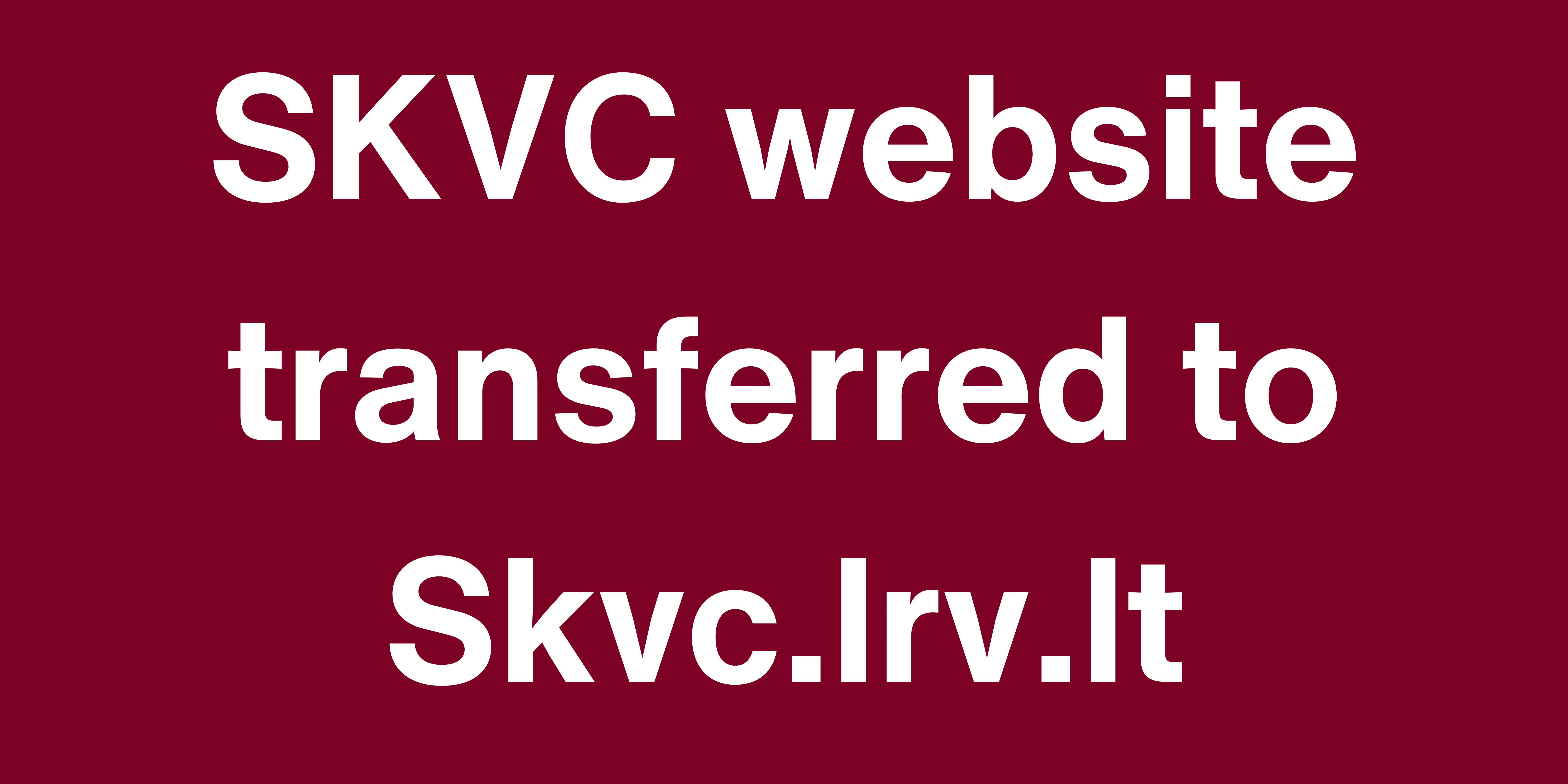General education providers can be state or private. Current types of general education providers are as follows:
- pradinė mokykla (primary school),
- progimnazija (pre-gymnasium) or pagrindinė mokykla (basic (lower secondary) school),
- gimnazija (gymnasium).
Under the school reform, since 1st of September 2017, secondary schools (vidurinė mokykla) which provided primary and basic (lower) secondary, and upper secondary education programmes, do not exist as a separate type of general education institutions.
The list of general education providers and general educational programmes which they are providing is presented at www.aikos.smm.lt.
General education system is with 12 years duration and consists of the following stages:
- primary education (pradinis ugdymas), 4 years;
- basic (lower secondary) education (pagrindinis ugdymas), 6 years;
- upper secondary education (vidurinis ugdymas), 2 years.
In 2006, external evaluation of general education providers (institutional assessment) was introduced and Nacionalinė mokyklų vertinimo agentūra (National Agency for School Evaluation, www.nmva.smm.lt) was authorised to provide such the assessment. Since 2017, the accreditation of the general education providers was established and this is under the authority of the Agency too. Only accredited school can provide upper secondary education programme.
Evaluation of primary education and basic (lower) education programmes, with exception of upper secondary education programmes, is not foreseen according to national legislation. However general education providers have to follow general requirements and standards, and general educational plans adopted by the Ministry of Education, Science and Sports.
Accreditation of upper secondary education programmes was established in 2004. External expert group evaluates upper secondary programme of a particular general education provider and decision regarding accreditation on the basis of evaluation results is taken by the Ministry of Education, Science and Sports.
Primary education (1-4 grades)
Primary education is compulsory. It lasts for 4 years, from 7 to 11 (in exceptional cases from 6 to 10). The purpose of primary education programme is the development of a healthy, active, and creative child who has acquired elementary literacy, social, informational and cognitive skills, which are necessary for proceeding to basic (lower secondary) education.
The programme consists of the following subjects: moral education (religion or ethics), languages (mother tongue and first foreign language), mathematics, perception of the world, arts (drawing, music, dance), and physical education. Schools may also choose to offer non-traditional curricula based on Montessori, Waldorf, Suzuki.
Pupil assessment may take any form, depending on the teacher, such as notes, reviews, and descriptions. However, no grades are given at this stage.
After successful completion of the primary education programme, pupils are awarded Pradinio išsilavinimo pažymėjimas (Primary Education Certificate).
Basic (lower secondary) education (5-10 grades)
Basic (lower secondary) education is compulsory and lasts for 6 years (ages 10/11 to 16/17). The purpose of basic education program is to provide an individual with the basics of moral, socio-cultural and civic maturity, general literacy and the basics of technological literacy, to cultivate national consciousness, to foster an intent and ability to make decisions and choices and to continue learning.
The programme consists of two stages: first stage is with 4 years duration (5th – 8th grades) and the second stage is with 2 years duration (9th – 10th grades, I-II grades in gymnasium). The purpose of first stage is to integrate the basics of knowledge, abilities and skills. The second stage is oriented to education of abstract thinking.
Since the 9th grade (I grade in gymnasium), student can choose subjects or modules of subjects depending on abilities and interests. The second foreign language is compulsory since 6th grade but can be started to learn in the 5th grade too.
Basic (lower secondary) education is offered by basic (lower secondary) schools, pre-gymnasiums, special schools, etc.
The program consists of the following subjects: moral education (religion or ethics), languages (mother tongue, first and second foreign languages), mathematics, natural sciences (chemistry, physics, biology), social education (history, geography, civil education, economics and enterprise, etc.), arts (drawing, music, dance, theatre, and modern arts), information technologies, technologies, physical education. Some subjects could be studied at an intensified level.
At this stage, assessment is criterion-referenced. A 1 to 10 marking system is used with 10 as the highest mark and 4 as the lowest passing mark.
Pupils who complete basic (lower secondary) education are awarded Pagrindinio išsilavinimo pažymėjimas (Basic Education Certificate) which is at NQF level 3 of and at EQF level 3. The certificate provides right to upper secondary education or vocational training programmes.
Basic (lower secondary) education can also be acquired at vocational education schools/centres (profesinės mokyklos, profesiniai centrai). The programmes offered by vocational education schools combine basic (lower secondary) and vocational training. The duration of such programmes is 3 years. After completion of such studies, pupils obtain Pagrindinio išsilavinimo pažymėjimas (Basic Education Certificate) and Profesinio mokymo diplomas (Vocational Education Diploma).
Upper secondary education (III-IV grades in gymnasium)
Secondary education is made available to everybody who has successfully completed basic (lower secondary) education. It lasts for 2 years (ages 17/18 to 18/19). The purpose of secondary education is to assist a person in the acquisition of general academic, socio-cultural and technological literacy, moral, national and civic maturity.
Upper secondary education is offered by gymnasiums, special schools, etc.
The core of the secondary program consists of the following subjects: moral education (religion or ethics), languages (mother tongue and foreign languages), mathematics, social education (history, geography, or an integrated social sciences course), natural sciences (biology, physics, chemistry, or an integrated natural sciences course), arts (drawing, music, dance, theatre, or modern arts), information technologies, technologies, and physical education. The choice of subjects for each pupil is based on individuality and differentiation.
After pupils complete secondary education curriculum, they have to take leaving examinations, which are of two types: state-level and school-level. School-level examinations are held and assessed at school, while state-level examinations are held and assessed at National Examination Centres. Up until 2010, all state-level examinations had an equivalent examination at school-level. From 2010, the following examinations are offered:
- State and school level: Lithuanian
- State level: Biology, Chemistry, Physics, History, Information Technology, Mathematics, Foreign languages (English, French, Russian, German), Geography (offered only as school-level in 2010-2011).
- School level: Native language (Belorussian, Polish, Russian, German), Arts, Musicology, Technologies.
All pupils have to take an obligatory examination in the Lithuanian Language, which consists of two parts, and 1 elective examination.
Previously more examinations were required, please see bellow:
| Period | |
| 1999–2001 | 5 examinations |
| 2002–2006 | 4 examinations |
| 2007–2009 | 3 examinations (Lithuanian and 2 electives) |
| Since 2010 | 2 examinations (Lithuanian and 1 elective) |
As in basic (lower secondary) education, assessment at school as well as in the school-level examinations is criterion-referenced. A 10 point scale is used with 10 as the highest mark and 4 as the lowest passing mark.
Until 2013, the results of the state-level examinations were norm-referenced rated on a 1–100 point scale. Since 2013, a criterion-referenced grading is being gradually introduced for state-level examinations with 100 as the highest mark and 16 as the lowest passing mark.
Pupils who successfully complete the secondary education curriculum and pass the required examinations are awarded Brandos atestatas (Maturity Certificate), which gives access to higher education in Lithuania. Brandos atestatas is at NQF level 4 and at EQF level 4.
Secondary education can also be acquired at vocational education schools/centres (profesinės mokyklos, profesiniai centrai). The programmes offered by vocational education schools combine upper esecondary education curriculum and vocational training. The duration of such programmes is 3 years. After successful completion of such studies, pupils obtain Brandos atestatas (Maturity Certificate) and Profesinio mokymo diplomas (Vocational Education Diploma). Brandos atestatas leads to higher education studies.
Digital verification of Maturity Certificates (Brandos atestatas)
From 2023-05-01 onwards general and vocational education credential diplomas, certificates and their duplicates are issued only as digital credentials, without a corresponding physical diploma. Thus, iinstitutions interested in authenticity of these credentials are directed to request a verification code and/or QR code from the owner of the credential that can be used to check their authenticity online. The official state register can be found by following this link: https://www.dakpr.smm.lt/aikos2-dakpr/edocSearch.xhtml. Additional information on the register and verification can be found here: https://www.dakpr.smm.lt/aikos2-dakpr/.
Useful links:
- The Ministry of Education, Science and Sports, www.smm.lt
- National Agency for Education, www.nsa.smm.lt
- Database AIKOS providing information on general education providers and their programmes, www.aikos.smm.lt
- Diploma, attestation and qualification certificates register (DAKPR): https://www.dakpr.smm.lt/aikos2-dakpr/




